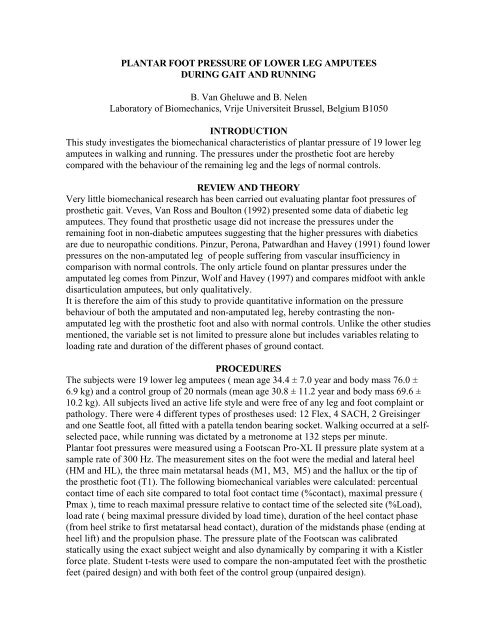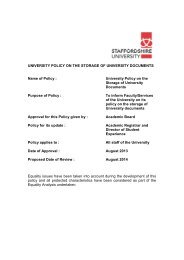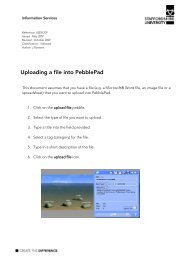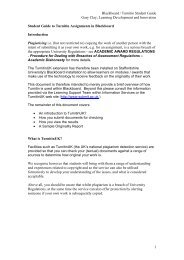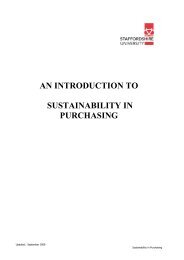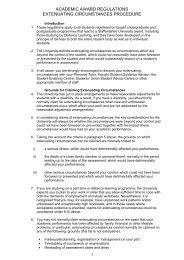PLANTAR FOOT PRESSURE OF LOWER LEG AMPUTEES ...
PLANTAR FOOT PRESSURE OF LOWER LEG AMPUTEES ...
PLANTAR FOOT PRESSURE OF LOWER LEG AMPUTEES ...
Create successful ePaper yourself
Turn your PDF publications into a flip-book with our unique Google optimized e-Paper software.
<strong>PLANTAR</strong> <strong>FOOT</strong> <strong>PRESSURE</strong> <strong>OF</strong> <strong>LOWER</strong> <strong>LEG</strong> <strong>AMPUTEES</strong><br />
DURING GAIT AND RUNNING<br />
B. Van Gheluwe and B. Nelen<br />
Laboratory of Biomechanics, Vrije Universiteit Brussel, Belgium B1050<br />
INTRODUCTION<br />
This study investigates the biomechanical characteristics of plantar pressure of 19 lower leg<br />
amputees in walking and running. The pressures under the prosthetic foot are hereby<br />
compared with the behaviour of the remaining leg and the legs of normal controls.<br />
REVIEW AND THEORY<br />
Very little biomechanical research has been carried out evaluating plantar foot pressures of<br />
prosthetic gait. Veves, Van Ross and Boulton (1992) presented some data of diabetic leg<br />
amputees. They found that prosthetic usage did not increase the pressures under the<br />
remaining foot in non-diabetic amputees suggesting that the higher pressures with diabetics<br />
are due to neuropathic conditions. Pinzur, Perona, Patwardhan and Havey (1991) found lower<br />
pressures on the non-amputated leg of people suffering from vascular insufficiency in<br />
comparison with normal controls. The only article found on plantar pressures under the<br />
amputated leg comes from Pinzur, Wolf and Havey (1997) and compares midfoot with ankle<br />
disarticulation amputees, but only qualitatively.<br />
It is therefore the aim of this study to provide quantitative information on the pressure<br />
behaviour of both the amputated and non-amputated leg, hereby contrasting the nonamputated<br />
leg with the prosthetic foot and also with normal controls. Unlike the other studies<br />
mentioned, the variable set is not limited to pressure alone but includes variables relating to<br />
loading rate and duration of the different phases of ground contact.<br />
PROCEDURES<br />
The subjects were 19 lower leg amputees ( mean age 34.4 ± 7.0 year and body mass 76.0 ±<br />
6.9 kg) and a control group of 20 normals (mean age 30.8 ± 11.2 year and body mass 69.6 ±<br />
10.2 kg). All subjects lived an active life style and were free of any leg and foot complaint or<br />
pathology. There were 4 different types of prostheses used: 12 Flex, 4 SACH, 2 Greisinger<br />
and one Seattle foot, all fitted with a patella tendon bearing socket. Walking occurred at a selfselected<br />
pace, while running was dictated by a metronome at 132 steps per minute.<br />
Plantar foot pressures were measured using a Footscan Pro-XL II pressure plate system at a<br />
sample rate of 300 Hz. The measurement sites on the foot were the medial and lateral heel<br />
(HM and HL), the three main metatarsal heads (M1, M3, M5) and the hallux or the tip of<br />
the prosthetic foot (T1). The following biomechanical variables were calculated: percentual<br />
contact time of each site compared to total foot contact time (%contact), maximal pressure (<br />
Pmax ), time to reach maximal pressure relative to contact time of the selected site (%Load),<br />
load rate ( being maximal pressure divided by load time), duration of the heel contact phase<br />
(from heel strike to first metatarsal head contact), duration of the midstands phase (ending at<br />
heel lift) and the propulsion phase. The pressure plate of the Footscan was calibrated<br />
statically using the exact subject weight and also dynamically by comparing it with a Kistler<br />
force plate. Student t-tests were used to compare the non-amputated feet with the prosthetic<br />
feet (paired design) and with both feet of the control group (unpaired design).
RESULTS AND DISCUSSION<br />
As expected the pressure patterns of the prosthetic leg differed significantly from the<br />
remaining leg for most variables and measuring sites, during gait as during running (table 1). It<br />
is, however, remarkable that peak heel pressures show no differences during gait. This<br />
confirms the results from Veves et al (1992) concerning the peak pressures of non-diabetic<br />
amputees for gait. But with increasing speed, as during jogging, the normal foot seems to<br />
accept higher peak loads than the prosthetic foot. Also the build up of pressure (load rate) is<br />
always much higher for the normal heel. This may be due to the dominant presence of the<br />
compliant Flex-Foot, which is known for its highly efficient return of stored energy during<br />
heel impact (Czernieckl, Gitter and Munro, 1991).<br />
As for the forefoot and in contrast with the stabilizing thrust being on the first metatarsal<br />
head in the normal foot, the prosthetic forefoot bears weight centrally. The maximal pressure<br />
under the forefoot is about the same for both feet, but the prosthetic forefoot shows a higher<br />
loading rate, probably due to its rigid metal structure.<br />
WALKING<br />
RUNNING<br />
%<br />
contact<br />
time<br />
Pmax<br />
(N/cm 2 )<br />
%<br />
load<br />
time<br />
load rate<br />
(N/cm 2 /ms)<br />
%<br />
contact<br />
time<br />
Pmax<br />
(N/cm 2 )<br />
%<br />
load<br />
time<br />
load rate<br />
(N/cm 2 /ms)<br />
HM n 45 ± 8 69 ± 20 12 ± 7 2.89 ± 1.33 49 ± 5 93 ± 33 12 ± 4 7.64 ± 5.10<br />
p 42 ± 13 64 ± 29 27 ± 9 0.99 ± 0.47 39 ± 18 66 ± 39 35 ± 9 1.95 ± 0.98<br />
HL n 45 ± 8 60 ± 22 13 ± 7 2.62 ± 1.87 48 ± 5 88 ± 34 10 ± 4 8.78 ± 6.14<br />
p 43 ± 13 61 ± 30 30 ± 8 0.77 ± 0.38 40 ± 17 66 ± 43 36 ± 8 1.89 ± 1.09<br />
M1 n 76 ± 7 40 ± 24 82 ± 6 0.09 ± 0.05 75 ± 6 55 ± 28 63 ± 10 0.44 ± 0.25<br />
p 61 ± 11 27 ± 9 68 ± 11 0.10 ± 0.04 63 ± 12 37 ± 17 59 ± 10 0.39 ± 0.23<br />
M3 n 79 ± 5 30 ± 13 81 ± 5 0.06 ± 0.02 75 ± 8 35 ± 9 64 ± 4 0.25 ± 0.09<br />
p 66 ± 9 43 ± 14 70 ± 12 0.15 ± 0.05 68 ± 12 62 ± 24 64 ± 9 0.54 ± 0.27<br />
M5 n 66 ± 9 13 ± 8 66 ± 13 0.04 ± 0.02 60± 9 22 ± 12 64 ± 11 0.21 ± 0.11<br />
p 63 ± 11 27 ± 8 68 ± 12 0.09 ± 0.04 59± 18 33 ± 14 62 ± 13 0.41 ± 0.42<br />
T1 n 56 ± 17 40 ± 21 74 ± 7 0.15 ± 0.06 74 ± 11 45 ± 26 62 ± 10 0.36 ± 0.20<br />
p 29 ± 18 47 ± 34 75 ± 9 0.32 ± 0.15 37 ± 19 33 ± 30 64 ± 10 0.46 ± 0.33<br />
Table 1: Mean and standard deviations of the plantar pressure variables of the prosthetic (=p)<br />
and the normal (n) foot for walking and running (bold figures indicate a significant difference<br />
between both means with p


